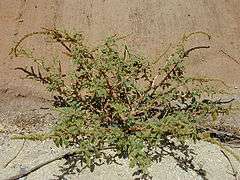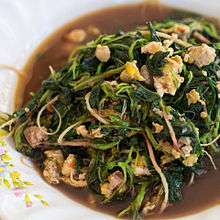Amaranthus spinosus
| Amaranthus spinosus | |
|---|---|
 | |
| Scientific classification | |
| Kingdom: | Plantae |
| (unranked): | Angiosperms |
| (unranked): | Eudicots |
| (unranked): | Core eudicots |
| Order: | Caryophyllales |
| Family: | Amaranthaceae |
| Genus: | Amaranthus |
| Species: | A. spinosus |
| Binomial name | |
| Amaranthus spinosus L. | |
Amaranthus spinosus, commonly known as the spiny amaranth,[1] spiny pigweed, prickly amaranth or thorny amaranth. It is native to the tropical Americas, but it is present on most continents as an introduced species and sometimes a noxious weed. It can be a serious weed of rice cultivation in Asia. [2]
Uses
Dye use
In Khmer language, it is called pti banlar and in Vietnamese giền and its ash was historically used as a grey cloth dye.
Food use

Like several related species, Amaranthus spinosus is a valued food plant in Africa.[3] It is valued also in Thai cuisine, where it is called phak khom (Thai: ผักขม). In Tamil it is called mullik keerai. In Sanskrit it is called tanduliyaka. it is used as food in the Philippines where it is called kulitis. The leaves of this plant, known as massaagu in the Maldivian language, have been used in the diet of the Maldives for centuries in dishes such as mas huni.[4] In Mexico it is among the species labelled Quelite quintonil in Mexican markets.
Medicinal use
The leaves of this plant have been used as a poultice for the skin treatments, such as for pimples and burns. Water extracts from its roots and leaves have been used as a diuretic.[5]
References
- ↑ "Amaranthus spinosusaccessdate=7 January 2016". Natural Resources Conservation Service PLANTS Database. USDA.
- ↑ Caton, B. P.; M. Mortimer; J. E. Hill (2004). A practical field guide to weeds of rice in Asia. International Rice Research Institute. pp. 20–21.
- ↑ Grubben, G.J.H. & Denton, O.A. (2004) Plant Resources of Tropical Africa 2. Vegetables. PROTA Foundation, Wageningen; Backhuys, Leiden; CTA, Wageningen.
- ↑ Xavier Romero-Frias, The Maldive Islanders, A Study of the Popular Culture of an Ancient Ocean Kingdom. Barcelona 1999, ISBN 84-7254-801-5
- ↑ Tanaka, Yoshitaka; Van Ke, Nguyen (2007). Edible Wild Plants of Vietnam: The Bountiful Garden. Thailand: Orchid Press. p. 22. ISBN 9745240893.